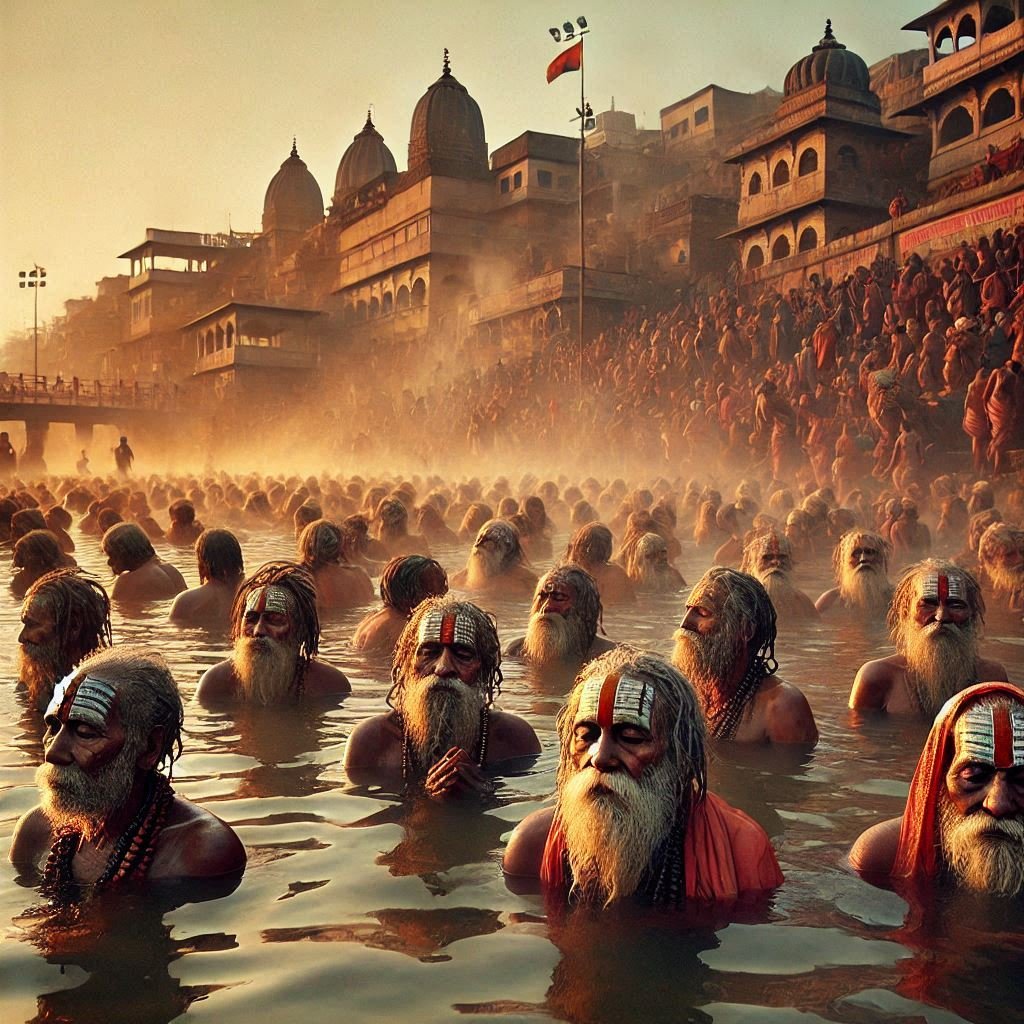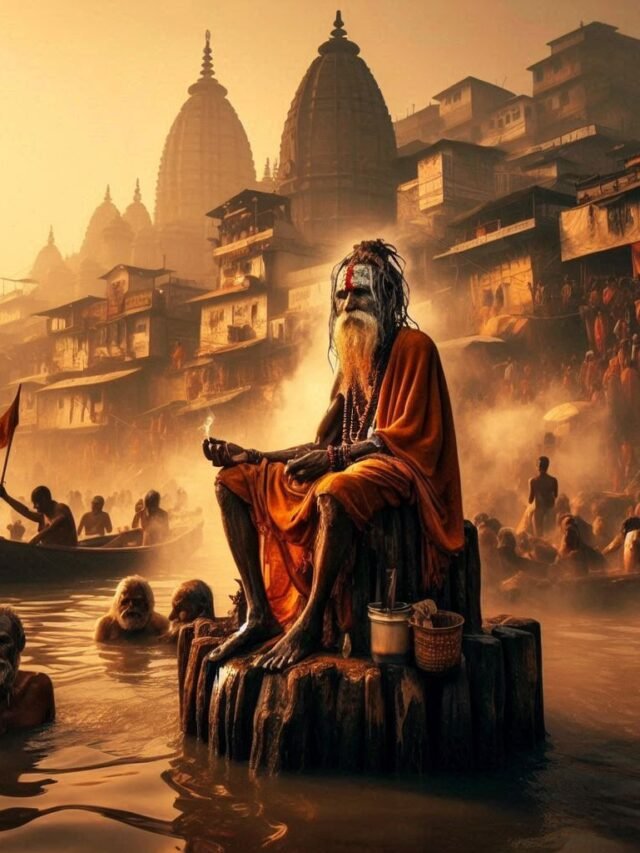The Mahakumbh, often hailed as the largest spiritual gathering in the world, is an extraordinary festival celebrated in India. This grand event holds immense cultural, religious, and historical significance. Tens of millions of Hindus are convening this week in what is expected to be the world’s largest human gathering, where a staggering number of devotees, tourists, politicians and celebrities take sacred dips at the convergence of two holy rivers in India.
Kumbh Mela
What is the MahaKumbh Mela?
The Maha Kumbh Mela, or “great festival of the sacred pitcher,” is the world’s largest religious ceremony. Based on a Hindu legend in which demons and gods fight over a pitcher carrying the nectar of immortality, the centuries-old ceremony centers on a series of holy baths, which Hindus say purify their sins.
The religious festival, called the MahaKumbh Mela, happens every 12 years on the banks of the Ganges and Yamuna rivers in the northern Indian city of Prayagraj. Officials this year expect up to 400 million people — more than the population of the United States — to visit the site in Uttar Pradesh State over the next six weeks.
A major display of Hinduism, the event has recently become an important political event with the rise of Hindu nationalism, backed by Prime Minister Narendra Modi’s right-wing political party. It is also a massive logistical undertaking for government officials working to prevent incidents like stampedes and the spread of diseases. Here are some lesser-known facts about the Mahakumbh that make it truly unique:
1. Rotation Among Four Sacred Sites
Mahakumbh is hosted once every 12 years, rotating among four sacred locations: Prayagraj, Haridwar, Ujjain, and Nashik. Each site represents a unique spiritual essence and is believed to be a place where drops of Amrit (nectar) fell during the mythical Samudra Manthan (churning of the ocean).The 12-year rotation of the Mahakumbh among Prayagraj (Allahabad), Haridwar, Ujjain, and Nashik is more than just a logistical arrangement. Each of these sites is deeply imbued with its own unique spiritual significance and historical narrative, linked to the mythical tale of the Samudra Manthan.
- Prayagraj (Allahabad): Situated at the confluence (Sangam) of the Ganga, Yamuna, and the mythical Saraswati rivers, Prayagraj is considered the most sacred of the four sites. The Triveni Sangam is believed to be the precise spot where drops of Amrit fell. The Magh Mela, an annual event held here, serves as a precursor and a smaller version of the Kumbh. The specific Kumbh held here is often referred to as the “Maha Kumbh” due to the significance of the Sangam.
- Haridwar: Located at the foothills of the Himalayas where the Ganga enters the plains, Haridwar (“Gateway to Hari/God”) has been a significant pilgrimage site for centuries. The Brahmakund at Har ki Pauri is the specific ghat (steps) where the Amrit is believed to have fallen. The Kumbh here is associated with the transit of Jupiter in Aquarius and the Sun in Aries.
- Ujjain: Situated on the banks of the Shipra River, Ujjain is historically significant as one of the primary centers of timekeeping and astrology in ancient India. The Kumbh here, known as Simhastha, is unique as its timing is determined by the transit of Jupiter in Leo (Simha in Sanskrit). The legend connects the Amrit drop to the victory of the gods over demons at this location.
- Nashik: Located on the banks of the Godavari River, the Kumbh here is also known as Simhastha and its timing is linked to the transit of Jupiter in Leo, similar to Ujjain, but with different solar and planetary configurations. The Amrit is believed to have fallen at Ramkund. The Kumbh at Nashik often has a distinct character influenced by the local traditions and the presence of various ascetic orders.
The 12-year cycle itself is tied to the roughly 12-year orbit of Jupiter. The rotation ensures that devotees have the opportunity to experience the unique spiritual atmosphere and participate in the sacred rituals at each of these powerful locations over their lifetime. The different astrological alignments at each site contribute to the distinct spiritual energy and specific rituals observed during each Kumbh.
2. Celestial Alignments Govern the Dates
The timing of the Mahakumbh is not random. It is determined by specific astronomical positions of the Sun, Moon, and Jupiter. These alignments are believed to create the most auspicious period for spiritual cleansing and achieving moksha.
3. Largest Gathering of Humanity
The Mahakumbh is recognized as the largest gathering of people on Earth. Millions of pilgrims, saints, and tourists from over 100 countries come together, making it a truly global event.
4. A UNESCO Cultural Heritage
The Mahakumbh has been inscribed on UNESCO’s list of “Intangible Cultural Heritage of Humanity.” This recognition emphasizes its deep cultural and spiritual roots.
5. A Mythological Origin
The legend of the Mahakumbh is rooted in the story of the Samudra Manthan, where gods and demons fought for the pot of Amrit. During the chase, drops of the nectar fell at the four locations where the festival is celebrated today. Beyond its spiritual significance, the Kumbh Mela historically served as a massive trading fair. Before modern infrastructure, people from all corners of India would gather, leading to significant commercial exchange of goods, livestock, and crafts. While less prominent today, remnants of this historical role can still be seen in the bustling markets that spring up alongside the religious activities.
6. Spiritual Processions and Akharas
The Mahakumbh features grand processions by 14 prominent Akharas (monastic orders), including the famous Nagas, known for their unique rituals and attire. The Naga Sadhus, the naked ascetics, are a prominent and often enigmatic part of the Kumbh Mela. Their strict vows of renunciation, extreme physical austerities (like standing for days or burying themselves alive), and secretive rituals are largely unknown to the general public. Their lifestyle and spiritual practices, often performed away from the main crowds, hold a deep and ancient spiritual significance.
7. A Global Spiritual Attraction
While deeply rooted in Indian culture, the Mahakumbh attracts spiritual seekers, photographers, and researchers from across the globe, making it a melting pot of cultures. While the general timing of the Kumbh Mela at each of the four sites (Prayagraj, Haridwar, Nashik-Trimbakeshwar, and Ujjain) is determined by specific astrological configurations of the Sun, Moon, and Jupiter, the precise moment for the most auspicious bathing (Shahi Snan or Royal Bath) is often calculated with extreme precision by learned astrologers and kept somewhat confidential until closer to the date. This ensures maximum spiritual benefit for those who bathe at that exact confluence.
The Mahakumbh is more than just a festival—it is a celebration of faith, devotion, and humanity’s eternal quest for the divine.
How big is the festival?
The scale of the Maha Kumbh Mela is astonishing. The last one, in 2013, drew 120 million people in Prayagraj, according to a government estimate. An intermediate festival in 2019, though less significant religiously, attracted 240 million people.
This year, the city, home to about 6 million residents, is preparing to host 300 to 400 million people, government officials said. In preparation, the state has built a temporary campsite across a 10,000-acre area, with tens of thousands of tents and bathrooms, roads, parking lots, water and electricity infrastructure and thousands of security cameras and drones. Some researchers suggest that the massive congregation at the confluence of rivers during specific astrological timings might have subtle, yet significant, effects on the water bodies themselves due to the sheer volume of human interaction and the specific energies believed to be present. While not fully understood or widely promoted, there are underlying beliefs and some nascent studies exploring this less obvious dimension of the Kumbh Mela.

